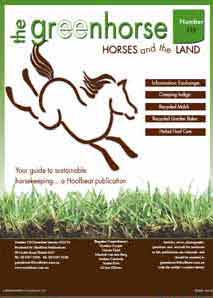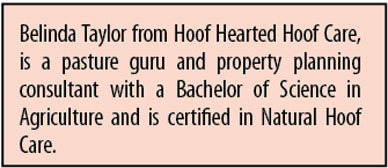The Green Horse section provides practical information on managing environmentally sustainable horse properties, readers stories and tips, as well as advice and articles from equestrian experts in their fields.
April/May 23
Vol 44 No 6
In this issue of The Green Horse you will find the following articles
AUTUMN ON THE PROPERTY - chores to prepare for winter.
by Rhiannon Brown – Envirapest
The cooler conditions are the
ideal prompt to start considering what should be done on the property before the arrival of
colder, wet days of winter, which means the spring weed season is not far away.
BUILDING THE DREAM PASTURE
by Teele Worrell
By starting the property
management journey with
property planning, weed control
and getting to know your soil, a landholder is perfectly placed to establish a diverse and productive pasture.
SIMPLE FEED BUDGET
by Belinda Taylor
Although most horse owners are nervous at the prospect of creating a budget, a few quick
calculations can give you the power to compare prices and alternatives that can reduce your horses’ feed
costs, without impacting on their health and wellbeing.
SO YOU WANT TO USE HERBS?
by Country Park Herbs
Using herbs with horses is not a new therapy. Traditionally many cultures have used herbs to keep their horses healthier and happier.
WIN A YEAR'S SUBSCRIPTION...
share your equine property management tips and each issue one reader will win.
Send ideas to -
The Green Horse Support <enquiries@hoofbeats.com.au>


PREVIOUS ARTICLES
Available on line
February/March 23
CROFTON WEED KILLS HORSES
by Angela Davison
If you have this weed on your property then it is best to not have any horses in the paddock until such time as you can eradicate it.
December/January 22 23 PROPERTY PLANNING
-Working with your property- not against it.
by Teele Worrell
Property planning is about
using your property effectively
and efficiently and sometimes
starting with a clean slate.
October/November 22
WHAT IS EQUESTRIAN LANDCARE
by Teele Worrell
Part 1 In a series in which Teele will explore what equine landcare is, and why it benefits equine landholders
August/September 22
THE IMPORTANCE OF GROUND COVER
by Belinda Taylor
Ground cover, whether it be dead grass, weeds, hay, or mulch is the insulating layer that protects your soil from the extremes of temperature and erosion.
June/July 22
SOLAR FOR YOUR ARENA
Environmentally-friendly solar lighting for your arena will allow you to use your arena for longer, and as energy from the sun is free it is therefore an ideal long-term solution for powering lights. Jeff Florence from Blackfrog Solar, Queensland suggsted some solar tips.
April/May 22
MAKING THE MOST OF MOSQUITO CONTROL
by Rhiannon Brown - Envirapest
Climate change that has brought high temperatures, more rain and increases in humidity will provide ideal breeding grounds for the many species of mosquitoes, including those that spread the Japanese Encephalitis virus (JEV).February/March 2022
February/March 22
SUSTAINABLE DEWORMING
by Sophie Fletcher
There has been a relatively big shift in deworming treatment strategies in recent years, due to increasing levels of worm resistance to the chemicals we have been using for decades to control them, resulting in a lot of confusion among horse owners.
December/January 21/22
ARE YOU PREPARED FOR THE FIRE SEASON
In the many areas where horse owners live this season's fire preparation should be well underway; if you’ve not already started preparing your property for summer then now is the time to do so.
October/November21
SNAKE UNIVERSAL ANTIVENOM
The good news is that there is no longer any need for a snake to be identified to administer antivenom. A universal antivenom is now used that covers the five genus of snake that will cause serious harm or death.
August/September 21
BEAT THE BINDI
by Rhiannon Brown - Envirapest
The prickly weeds that grow on our properties across Australia usually have long classical Latin names, are often known by a variety of common names in different localities but are regularly called very rude names when we happen to stand on one (or a dozen) or when they find our hands as we are dislodging tangles in the horse’s mane or tail.
June July 21
BARN OWLS by Wendy Elks
A silent partner in rodent control.
Non-toxic pest management is the most humane and ecologically sustainable way of bringing nature back into some kind of balance during non-plague times.
April/May 21
LOVELY LAWNS
by Rhiannon Brown - Envirapest
On a horse property there always seems to be hectares of grass, but we all have that little bit of lawn we want to look luscious all year round.
It could be the entrance to the stables, laneways bordering the driveway, that little ‘special’ snack paddock or you could even dream of a beautiful green arena. So, how do we achieve this?
Feb/March 21
STABLE DANGERS
by Elizabeth Tollarzo
They say that horses are accidents-waiting-to-happen as they are inclined to find every conceivable way to injur themselves, usually just before a competition. Being aware of potential dangers in the stable - and addressing these - may help aleiviate injury.
Dec/Jan 20/21
HORSES AND HONEY BEES-
Can they share space on the property?
by Wendy Elks
Oct/Nov 20
SOLAR-POWERED PRODUCTS
by Celine Bønnelykke
In previous issues we have discussed the economics of setting up a solar-driven property, but if finances don’t stretch to installation of the whole package, there are ways to ease into the solar-world.
Aug/Sept 20 THE HIDDEN DANGERS IN OUR PADDOCK.
by Elizabeth Tollarzo
Horses love to run, play, buck and then run again and we often, through lack of risk assessment or management practices, place them in areas that are fraught with dangers.
JUNE JULY 20 GOING SOLAR ON THE HORSE PROPERTY Where to put your panels Part 2
Once you have selected what solar system best suits your needs, then you need to look at how you can maximise the advantages.
APRIL MAY 20 GOING SOLAR ON THE HORSE PROPERTY Part 2
Once you have selected what solar system best suits your needs, then you need to look at how you can maximise the advantages.
FEB/MARCH 20 ANTS AWAY
by Mark Brown Envirapest
So, what can you do to deter ants from your house and your stables??
DJ19/20 KEEPING SNAKES OUT OF THE STABLE by Wendy Elks
Snakes may be protected under Wildlife regulations in Australia, and they may be great for keeping the mice and rats down, but do we want to find them in our stables near our horses and pets?
ON19 - TERMITES- common myths
by Rhiannon Brown, Envirapest
Your house and stables are looking wonderful this spring, but do you know what is happening inside the walls of your brick or timber building?
AS19 - OUCH THAT HURTS
by Catherine Bird for Country Park Saddlery
The extent of the swelling is usually an indication of the severity of the infection or injury and the cause needs to be established before giving herbs.
JJ19 - MANAGING PASTURE
by Rhiannon Brown, Envirapest Healthy pasture means healthy horses.
A/M19 - STOP THOSE WEEDS
Property biosecurity
by Rhiannon Brown, Envirapest
Putting simple precautionary steps into place can make it tough for weeds to get a hold on your equine paradise.
|
  
  


Although most horse owners are nervous at the prospect of creating a budget, a few quick calculations can give you the power to compare prices and alternatives that can reduce your horses’ feed costs, without impacting on their health and wellbeing.
With rising prices hitting our pockets at every turn, now is a great time to look at feed budgeting. A feed budget is an assessment of the type, amount and price of the feeds you are using to meet your horse’s nutritional requirements. Usually when I mention the word budget, most horse owners want to stick their fingers in their ears and sing “la la laaa”. But in today’s economic environment, it pays to know what you need and shop around to find the best prices.
The budget can be as technical or as simple as you like. On the technical side of things, you can work with an equine nutritionist, to get a fairly precise list of the number of kilograms of each feed component you need to feed per day. Multiply it by the number of days in the year and then divide it by the bag/roll/bale size and “Voila”! You have produced a list of the amount of feed you need annually to keep your horse in tip top condition. Using this list you can then price up each feed type and know what it is costing you per year.
On the simpler side, just jotting down how much basic feed you are buying each week/fortnight and working those numbers forward into an annual amount can give you a place to start from.
SAMPLE BUDGET
Using two Warmbloods as a rough example the following budget shows options for saving potentially thousands over the year.
The two Warmbloods are being fed 1.2 metre (four foot) meadow hay rolls ad lib with a small hard feed each day. They are grazed during the day on pasture, based on ground cover and pasture availability.
Hay
• 1 x 1.2 metre meadow roll per week over summer/autumn = 25
• 1 x 1.2 metre meadow roll per fortnight winter/spring = 12
Total = 37
Hard feed
1 x 20kg bag of Maxisoy per week = 52
1 x 25kg of flaked lupins per week = 52
A quick budget based on current prices tells me my annual feed bill (give or take, as rainfall and pasture growth will determine how much grazing time they get and this will vary hay intake)
37 x1.2 metre meadow hay rolls
@$135/roll = $4995
52 bags of Maxisoy
@ $40/bag = $2080
52 bags of Flaked Lupins
@ $25/bag = $1300
Total cost = $8375/year
or an average of $161/week
Now that I have a rough cost of my current feed system, I can start comparing prices and alternatives.
If I was to swap to 1.2 metre oaten rolls @$100/roll, I will save myself $1295/year.
If I was to swap from Maxisoy to lupin fibre, I could save myself another $520/year.
If I was to swap from flaked lupins to whole lupins and soak instead, I could save myself another $260/year.
So just through some basic substitution, I can save myself over $2000. If I was looking to further improve the bottom line, I could then look at what discounts may be available if I was to buy in bulk or direct from the farmer. If you have friends that all feed the same thing, you may find ordering by the pallet can offer you a discount.
Feed budgeting can sometimes be an eye opening exercise, when you work out just how much your horses can cost you to feed, but a few quick calculations can give you the power to understand all the options and alternatives that can save you money in the long run and help manage increasing cost pressures.

|